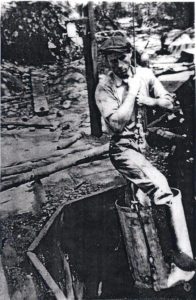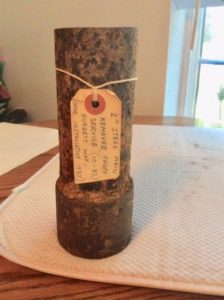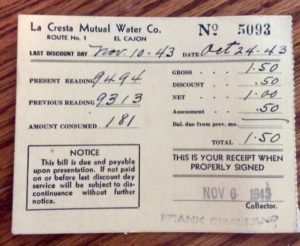Water - A Precious Commodity
Water – A Critical Factor – 1929
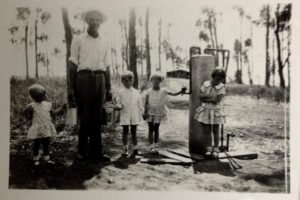 As the population grew, it stressed the water system which consisted of wells. Both communities had a similar challenge to deal with – a shortage of water. During the depression years, more and more people moved into their places as permanent homes. In 1929, all water stand pipes were taken out and water was to be piped directly to the cabins at a one-time flat rate charge of $25. It was emphasized that only owners of the cabins were allowed to use the water. Pictured above is a typical water spigot.
As the population grew, it stressed the water system which consisted of wells. Both communities had a similar challenge to deal with – a shortage of water. During the depression years, more and more people moved into their places as permanent homes. In 1929, all water stand pipes were taken out and water was to be piped directly to the cabins at a one-time flat rate charge of $25. It was emphasized that only owners of the cabins were allowed to use the water. Pictured above is a typical water spigot.
Then came the problem of owners using more than their share of water. As a result, there were many weekends when there was just not enough water to go around. The original well was then deepened and gave relief for a short time, after which a second well was dug to give added relief.
Each community had wells that supplied their homes with water. La Cresta residents had their own water supply obtained from a well in Kalamity Canyon down La Cresta grade, not far from the top of the hill. The La Cresta Mutual Water Company was formed by B.A. Cornelius, Martin Ettel, O.V. Jarrett, John Livingston, and Joseph Robbins. The 1936 fee for a water connection with the Suncrest, Inc. water system was $1.50- payable at time of filing application. Nancy Cornelius Glasscock writes, “My father, Barney, was the one who dug the three wells and a cave to furnish La Cresta with water. He also engineered the big water tank on Highline Trail. He pumped the water to this tank and if he caught you wasting water or washing a car, he gave you a tongue lashing, two strikes and you are out! The third time he shut your water off and you would have to make a solemn promise not to repeat the offense.”
Miriam Smith recalled the water shortage. “We were living at the corner of Alegria and North Lane and were among the first to have the water fail to flow when you turned on the faucet. This was particularly bad in the shower when you turned it off momentarily to apply the shampoo and soap to your body then later it could not come back on! I have been known to get all dressed, soapy from head to toe, and drive down to a friend’s house in El Cajon to shower off.”
The Suncrest well was located down the old grade on Suncrest Blvd. At some point in the 1940s the well dried up, and for a time residents got water from a water truck parked at the Suncrest Clubhouse – a maximum of 5 gallons a day. While the water eventually returned, a short time later both the Suncrest and La Cresta’s wells dried up.
Another well was located in Suncrest near Juanita Lane and Park Drive and was used to supply the Suncrest swimming pool with water. The pool closed when water issues became critical.
A Water Scandal to Remember
One Suncrest part-time resident, we will call him Mr. X, lived in San Diego. He and his family owned a summer cabin in Suncrest. Mr. X developed a large grape vineyard on his property and secretly and illegally tapped a Suncrest, Inc. water line. The main line ran parallel to his acreage near the junction of Suncrest Blvd. at Crest Drive, across the road from the present day location of the Catholic Church.
The illicit water was siphoned and used to irrigate his numerous grape vines on the eastern slope of his land. At the time, water was scarce and only limited quantities of the precious liquid was available to Suncrest residents. Eventually Mr. X’s clandestine operation was discovered, and he was penalized by having all water privileges permanently revoked. As a result, all his future water supplies for household use had to be brought in from outside sources.
Although unconfirmed, it was alleged that he fermented bootleg wine in the cellar of his cabin. Presumably, his wine making came to an ignominious end.
La Cresta Residents “Borrowing” Water from the Suncrest Well?
In the time period 1934-1937, the following resolution was adopted by Suncrest, Inc.: Whereas there is an apparent shortage of water in La Cresta and due to said shortage, the residents of La Cresta are taking water from the system of Suncrest. Be it resolved that the spigot at the filter be provided with a lock and keys to be furnished to members of Suncrest,
The Crest Public Utility District – 1944
The first water district was formed in July of 1944, after which the water systems of Suncrest and La Cresta were turned over to the District for operation. This combined the La Cresta and Suncrest wells into a mutual water system serving the entire Crest’s water supply. Water continued to be a problem and eventually a new pumping plant, water line, and reinforced concrete reservoir was installed and put into operation.
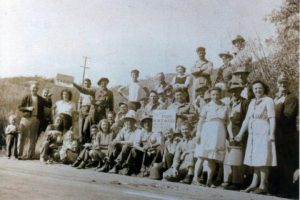
In 1947 the community had to take critical measures to continue to have water. Stanley Andrews, the sporting goods businessman, was living at the bottom of the La Cresta hill and had water on his property. He generously allowed the community to pump water up the hill from his land to keep the taps flowing. This required a huge volunteer effort to lay a pipeline up the three miles to Crest and hook up to this source at the Andrews’ place.
In the meantime, the Crest Public Utility District was led to annex to Helix Water District in order to get entitlement rights to import water from San Diego County Water Authority. Helix built a 6” steel and concrete line pipe that carried water 7,625 feet uphill to Crest from the Helix Water District’s flume line. Two concrete water storage tanks with a capacity of just under one-half million gallons were installed on Crest mountaintops in 1949 and 1959. CPUD continued to pump water up the hill until 1985. Bill Jenkins worked for the Crest Public Utility Company for three years doing everything from reading meters to helping to bring the water pipes up the hill. Bill said, “You would never know where the water pipe would be with the summer heat. Sometimes it would get shoved onto the dirt road and you’d have to be careful not to run over it.” Water was obtained from the Colorado River from the water mains of La Mesa, Lemon Grove, and Spring Valley Irrigation District. In 1950, numerous fire hydrants were installed throughout the Crest community.
The Crest Civic League notes reflected that as of November 1950, “There are now approximately 1,200 residents based on a total of 275 water meter users in the Crest Public Utility District.
The committee stated the prospects of growth were considered very good due to the installation of a new water system. The District is connected to the La Mesa-Lemon Grove-Spring Valley Irrigation District water mains as of May 1950.
Water meter connections revealed that 470 families resided in Crest in 1967
Mountaintop Mutual Water Company formed in North Crest – 1950
Raymond Scruggs was one of the organizers and a board member of the Mountaintop Mutual Water Company. In the 1950s, North Crest had its own water department which was not affiliated with the Crest Public Utility District. The Crest Public Utilities Commission served the La Cresta and Suncrest areas. Water connections were available for $110 because there were no bond obligations. Rio San Diego Water District, however, which served the La Cresta Heights area, still had bond obligations which made the water meter connections a steep $565.
1985 – Padre Dam Water Company annexes Crest Public Utility District
Fears about rising costs of maintaining its aging infrastructure, plus the need for greater water storage, led Crest to merge the Crest Public Utility District with Padre Dam Municipal Water District. The system was several years past it’s 30 year life span. No plans had been made, or funds set aside, to compensate for this normal aging process. The amount of $1.62 million was needed to re-vamp the aging system. An agreement was finally reached that Crest would pay for the needed upgrade to the pumping system. Crest residents continue today to see the “past debt service” fee on their Padre Dam bills. There was much dissent regarding the merger issue as residents gave up the local control of the utility district. In the end, the measure passed. An article in the Crest Grapevine reported that the Crest water pipe contract was awarded to the Mur-Vic Co of San Diego who submitted the low bid of $365,052 for replacing some 13,000 feet of water pipe in 17 separate locations within the Crest Water District.
